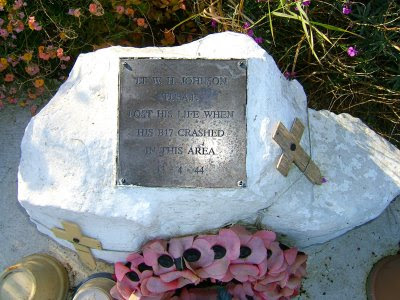Once more Remembrance Day comes around and we buy and wear our poppies with pride. This year I would like to remember a brave man, an American pilot of the Second World War.
On my cycle rides through this peaceful countryside I often stop as I pass by this shrine and there are others too. You see, Romney Marsh, being flat and close to France was the site of many airfields during that war.
A guest to our country, let's talk about Lieutenant Johnson. His memorial is known as "Johnson's Corner" and the "Stars and Stripes" flies proudly over the English countryside there every day. .
.

These faded poppies from last year will soon be renewed on November 11th.
(click images to enlarge)
There is a citation, obviously written by one of his surviving aircrew. One must do justice by quoting it in full:
Lt. W. JOHNSON US 8th Army Air Force.
This Corner is named after, and the Stone erected to one of the courageous Airmen of the Second World War. He gave his life to save his crew.
Pilot Lt. W. Johnson & crew, flew from Rattlesden, Suffolk in a B17. Take off time was 4.40 am. on Friday 13th. April 1944. Their target being the Messerschmitt Factory at Augsburg, Germany.
When in formation, their position being No. 4 Lead Squadron, they crossed the English Channel, entering into enemy territory between Ostend and Dunkirk. No flak for the first 90 miles. Then! All of a sudden, there were black puffs of smoke and cracking noises, bouncing the plane about.
Lt. Whitely, co-pilot, reported No. 4 engine stopping and No. 3 not running well. Finally, with No. 3 feathered (Turning the propeller blades into the wind to stop wind milling.) they left formation and headed for home. Flying over Abbeville France at 23,000 ft. they were hit by heavy flak. No 1 & 2 engines still running, they were losing height about 500 ft. per minute.
Orders were given to Sgt. Williams (right waist gunner), to dump all loose items and start to remove the Ball Turret. All bombs were dropped. Sgt. Zeiger (left waist gunner) was to stay on intercom and help Sgt.J Higgins (radio & gunner). Sgt. P. Simpson (ball turret gunner ) and Sgt. Williams were told to release the ball turret. They nearly went with it. We were hit continuously over Abbeville. Looking down through the ball turret hole it looked like the 4th. of July. ( Independence Day.)
The plane was badly damaged. The crew suffered casualties. Lt. Nye (bombardier) had a badly damaged arm, Lt. Francher (navigator) had quite a hole in his leg, but kept them on course in spite of the pain. Lt. Whitely had a hole in his wrist.
The plane’s cables were shot out, No. 2 engine was running but not good. They crossed the channel with No. 1 engine at maximum revs. The port fuel tanks were very low and fuel could not be transferred from the starboard tanks because the electrical pump had failed and the wabble pump had been hit. When they finally left enemy territory they were at about 12,000 ft. and they were losing altitude faster now that they only had one good engine. They prepared for ditching in the Channel. Sgt. Higgins notified Air Sea Rescue. Lt. Fancher said they would see land in a few minutes. Looking down, an Air Sea Rescue boat was below them, just in case they had to bale out over water. They crossed the British Coastline near Hythe at 2,000 ft. The oil line on number 2 engine fractured and immediately caught fire. The flames came past Sgt. Zeigler’s waist gunners window. He then noticed that the horizontal stabliser was missing.
Lt. Johnson gave the order to bail out.
Lt. Johnson, Lt. Whitely and Lt. Fancher, using their skills, is the reason they all returned even though they were badly wounded. Sgt. Hazzard (engineer & gunner) did an excellent job of giving medical aid, and should have been given an award.
They started to bail out at Lympne over Romney Marsh. Sgt. Zeiger states that when his parachute opened he noticed that the main wings were very badly damaged. They looked as though a can opener had been at work. The last man out jumped at 800 ft. leaving just the Pilot, Lt. Johnson, who died when the plane crashed.
The crew were very saddened at the loss of Lt. Johnson, as they knew that he gave them priority.
Lt. Johnson was nominated for the Congressional Medal of Honor. He was awarded the Distinguished Service Cross posthumously.





